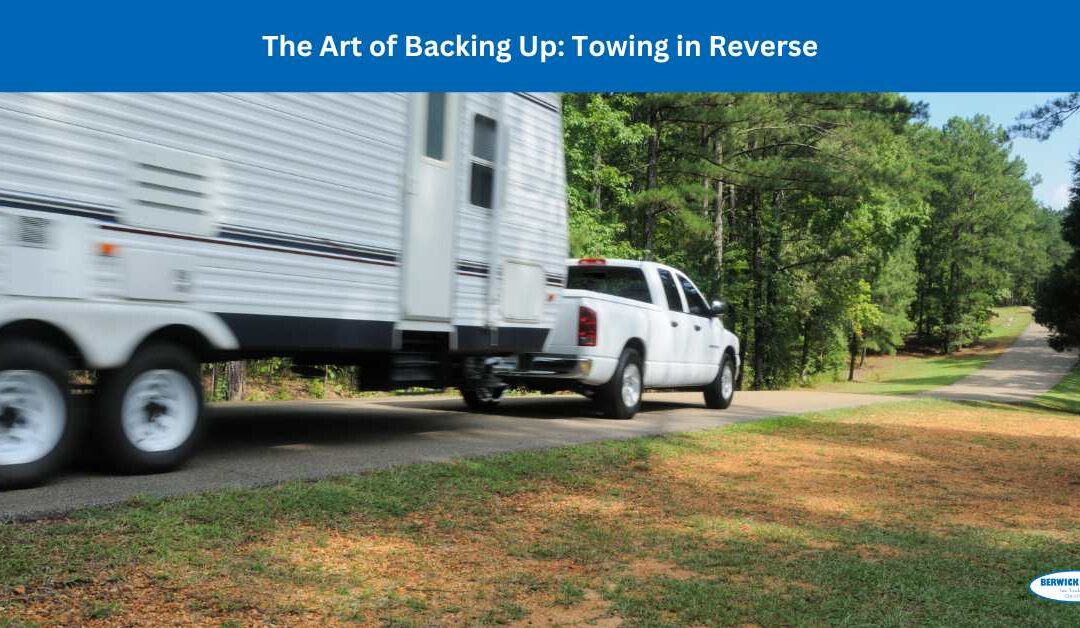Backing up with a trailer attached is a skill that requires patience, precision, and practice. Whether you’re parking, maneuvering in tight spots, or preparing for a tricky tow job, knowing how to reverse effectively is crucial. This guide breaks down the fundamentals, techniques, and tips for mastering the art of towing in reverse.
1. Understanding the Basics of Towing in Reverse
Backing up with a trailer involves counterintuitive movements. The vehicle and trailer must work in harmony, and the first step is understanding how each part reacts when reversing.
- Opposite Steering: When reversing with a trailer, the trailer moves in the opposite direction of the steering wheel. For example, turning the wheel to the right makes the trailer go left, and vice versa.
- Trailer Length and Response: Longer trailers respond more slowly to steering inputs, while shorter trailers turn quickly with smaller adjustments. Knowing your trailer’s length helps gauge how quickly it will react.
- Pivot Point: The hitch point, where the trailer attaches to the vehicle, acts as a pivot. Every steering adjustment affects this pivot, changing the trailer’s angle.
2. Setting Up for Reverse Maneuvering
Preparation is key when reversing with a trailer. Setting up correctly can make the process smoother and reduce the need for major corrections.
- Find a Starting Position: Start by aligning the tow vehicle and trailer in a straight line. Positioning the trailer straight before backing up gives you more control from the start.
- Clear the Area: Check the surroundings for obstacles. Make sure the area behind the trailer is clear, and know your escape route if needed.
- Use Mirrors Wisely: Adjust your mirrors to give a clear view of the trailer’s sides. Wide-angle mirrors or convex mirrors can expand your field of vision, making it easier to track the trailer’s movements.
- Engage a Spotter: If possible, use a spotter to provide guidance. A spotter can stand at a safe distance and relay directions, helping you avoid obstacles you may not see.
3. Techniques for Backing Up with a Trailer
Once you understand the basics, practice these techniques to improve your control and confidence when reversing with a trailer.
- The “S” Curve: To back up in a straight line, try the “S” curve method. Start with a slight turn in the opposite direction of where you want the trailer to go, then gently correct the steering to bring the trailer straight. This back-and-forth movement helps counteract trailer drift.
- Slow and Steady: Small, slow adjustments prevent overcorrecting, which is a common issue. Moving slowly allows you to see how the trailer reacts and gives you time to adjust.
- Hold the Bottom of the Wheel: Place your hand at the bottom of the steering wheel. Moving your hand left or right from the bottom directly correlates with the direction the trailer will go, which simplifies control.
- Adjust in Segments: Instead of trying to maneuver the trailer in one continuous movement, make small adjustments in segments. Stop periodically to assess alignment and correct the angle.
4. Backing into a Parking Spot or Dock
Parking with a trailer requires precision, especially when backing into a tight space. Here’s how to approach it:
- Angle Entry Method: Position the trailer at an angle to the target space. Begin by turning the wheel away from the direction of the parking space, then gradually straighten out to guide the trailer into position.
- Corrective Steering: Once the trailer is angled correctly, straighten the wheel and move backward. Adjust the steering to keep the trailer aligned within the parking lines.
- Practice Patience: It may take several tries to perfect the parking. If the trailer isn’t aligned, pull forward to reposition and try again. Patience reduces stress and improves accuracy.
- Using Landmarks: Use visual markers, such as painted lines, curbs, or cones, as guides. These help with alignment and orientation, especially when working with limited visibility.
5. Common Challenges and How to Overcome Them
Reversing with a trailer presents several unique challenges. Here’s how to handle common issues that can arise while backing up:
- Jackknifing: This happens when the trailer angle is too sharp relative to the vehicle, creating a “V” shape that limits further movement. To avoid this, make small adjustments and don’t let the trailer swing too far in one direction. If a jackknife occurs, pull forward and straighten the trailer before resuming.
- Limited Visibility: Mirrors only provide so much visibility. For longer or wider trailers, consider using a rearview camera if your vehicle has one. A spotter can also help fill in any blind spots.
- Oversteering: When beginners see the trailer moving in the wrong direction, they often make large steering adjustments, leading to oversteering. Counteract this by making gradual corrections. Small, measured movements result in smoother, more controlled reversing.
- Trailer Drift: Trailers can drift to one side if you’re not constantly monitoring alignment. Pause periodically to check the trailer’s position and adjust as needed.
6. Practice Makes Perfect
The best way to improve your reversing skills is with practice. Here are some exercises to try in a safe, open space:
- Straight-Line Reverse: Practice backing up in a straight line without making major steering adjustments. This builds confidence and gives you a feel for the trailer’s response time.
- 90-Degree Turn: Set up cones or markers to simulate a 90-degree parking space. Practice reversing into the spot using the angle entry method. This exercise improves your precision and spatial awareness.
- Serpentine: Set up a few cones in a line and practice maneuvering the trailer through them. This drill sharpens your steering control and reaction time.
- Parallel Parking: Parallel parking is challenging with a trailer, but practicing this skill gives you better control and positioning when reversing into tight spots.
7. Safety Tips for Reversing with a Trailer
Safety should always be a priority when maneuvering a trailer in reverse. Here are some precautions to follow:
- Clear Communication with Spotters: Agree on hand signals or voice commands with your spotter. Avoid confusion by using consistent signals that both of you understand.
- Check Surroundings Continuously: Reversing with a trailer requires constant awareness. Look in all mirrors and monitor the trailer’s position to ensure it stays within a safe range.
- Adjust for Weather Conditions: Rain, fog, and poor lighting can impact visibility and traction. In adverse conditions, go even slower than usual and double-check mirrors and surroundings.
- Be Mindful of Pedestrians and Vehicles: In busy areas, watch for pedestrians and other vehicles. If you’re unsure of your surroundings, use a spotter to help guide you safely.
8. When to Pull Forward and Reposition
Sometimes, despite best efforts, the trailer ends up misaligned. Don’t hesitate to pull forward to realign rather than continuing to adjust in reverse.
- Early Realignment: As soon as the trailer begins to move in the wrong direction, stop and pull forward to straighten. Small realignments are easier to handle than major corrections.
- Avoiding Frustration: If you’ve made several adjustments and the trailer is still off course, pull forward to start fresh. This reduces stress and provides a cleaner approach.
Conclusion
Mastering the art of towing in reverse takes patience and practice, but it’s a skill that brings confidence and control to every towing job. Whether you’re maneuvering in tight spots or backing into a parking space, following these tips will improve your technique and help you avoid common mistakes. Remember that every vehicle and trailer combination handles a little differently, so take your time to learn the unique nuances of each setup. With enough practice, you’ll be able to reverse any trailer with ease and accuracy.
If you are in Berwick, Victoria 3806, Australia, and looking for a car removal service, this is the best way to visit us.
Contact Us
Berwick Towing & Transport
27B William Rd
Berwick VIC 3806
(03) 7035 7815
www..berwick-towing.com.au/

